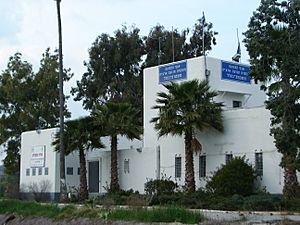Tegart fort facts for kids
A Tegart fort is a special type of strong police station. These forts were built across a region called Palestine when it was under British rule. They were started in 1938 to help stop a big uprising known as the Arab Revolt.
Contents
What's in a Name?
These forts are named after the person who designed them: British police officer and engineer Sir Charles Tegart.
Sometimes, in Israel, people say "Taggart" instead of "Tegart." This might be because of how the name was written in Hebrew and then changed back to the Latin alphabet.
A Look Back in Time
How They Were Built
Sir Charles Tegart designed these forts in 1938. He used what he learned from his experiences dealing with unrest in India. The forts were made from strong, reinforced concrete. They also had their own water systems. This meant they could last for about a month if they were surrounded and attacked.
Two main kinds of forts were built:
- Five forts were made with a special design to strengthen the "Tegart's wall" along the northern border with Lebanon and Syria.
- Many more forts, with a different but common design, were built at important crossroads inside Palestine.
The company that built these forts was called Solel Boneh. It was the building part of a Jewish trade union called Histadrut.
Tegart Forts Today in Israel
Many Tegart forts are still standing in Israel today. They are often used as police stations or even jails. One of them holds a special prison for "high-risk" prisoners called Camp 1391.
For example, the Tegart fort in Ma'alot-Tarshiha is now a police station. It's being fixed up to become a historical landmark. This means it's important for history and attracts people who want to see old buildings and tourists.
Tegart Forts in the West Bank
In the West Bank, some of these forts are now called Mukataa. This Arabic word means "District." They are used as offices and main centers for the Palestinian National Authority.
The Ramallah Mukataa was damaged during fighting in 2002. Later, it was repaired and made bigger by President Mahmoud Abbas. This made it harder to see what the original British building looked like.
The fort in Hebron was used by different groups over the years. It was a headquarters for Jordan, then for the Israeli military, and later for the Palestinian Authority. This fort was destroyed in 2002 during more fighting.
Some Tegart Forts and Their Uses
Many Tegart forts were built, and some are still in use today. Here are a few examples:
- The fort in Acre is still an active police station.
- The Atlit police station is now part of an Israeli military prison.
- The Beersheba police station is now the main office for the Southern Command in Israel.
- The Iraq Suweidan police station is now a museum for the Givati Brigade.
- The Latrun police station is now a museum for the IDF's armored vehicles.
- The Nabi Yusha police station is now a memorial and museum about a battle from 1948.
- The Ramallah police station was largely destroyed but is now part of the Palestinian Authority's main headquarters.
See also
- Shlomo Gur
- Tower and stockade
- Boma (enclosure)
Images for kids







